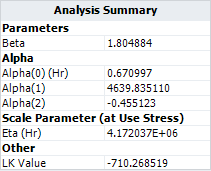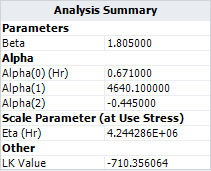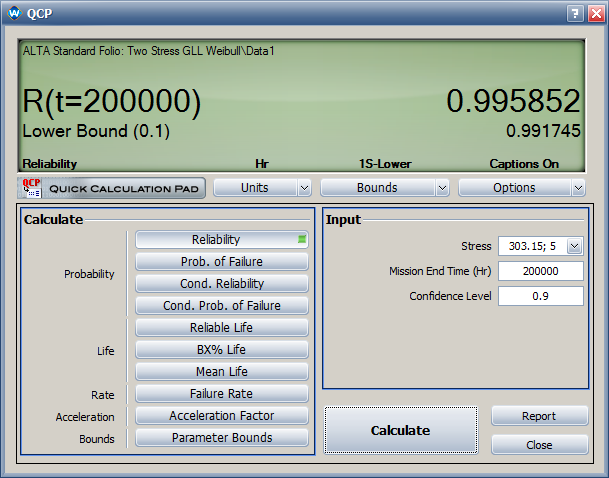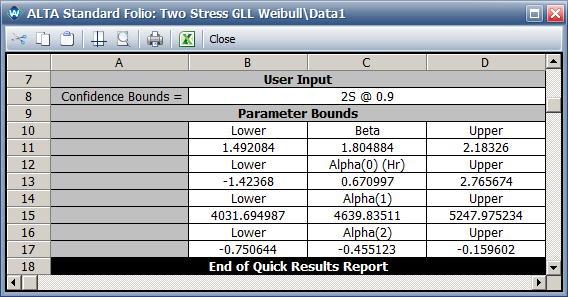|
Temperature-Nonthermal (TNT)-Weibull Model
|
This example compares the results for the temperature-nonthermal life-stress relationship with a Weibull distribution.
Reference Case
Data is from Table 7.10 on page 300 in book Life Cycle Reliability Engineering by Dr. Guangbin Yang, John Wiley & Sons, 2007.
Data
Temperature and switching rate are the two stresses used in the accelerated life test for a type of 18-V compact electromagnetic relay. The cycles to failure are provided next.
| Number in Group
|
State F/S
|
Time to State
|
Temperature (F)
|
Switching Rate
|
Subset ID
|
Number in Group
|
State F/S
|
Time to State
|
Temperature (F)
|
Switching Rate
|
Subset ID
|
| 1 |
F |
47154 |
337.15 |
10 |
1 |
1 |
F |
29672 |
398.15 |
10 |
3
|
| 1 |
F |
51307 |
337.15 |
10 |
1 |
1 |
F |
38586 |
398.15 |
10 |
3
|
| 1 |
F |
86149 |
337.15 |
10 |
1 |
1 |
F |
47570 |
398.15 |
10 |
3
|
| 1 |
F |
89702 |
337.15 |
10 |
1 |
1 |
F |
56979 |
398.15 |
10 |
3
|
| 1 |
F |
90044 |
337.15 |
10 |
1 |
6 |
S |
57600 |
398.15 |
10 |
3
|
| 1 |
F |
129795 |
337.15 |
10 |
1 |
1 |
F |
7151 |
398.15 |
30 |
4
|
| 1 |
F |
218384 |
337.15 |
10 |
1 |
1 |
F |
11966 |
398.15 |
30 |
4
|
| 1 |
F |
223994 |
337.15 |
10 |
1 |
1 |
F |
16772 |
398.15 |
30 |
4
|
| 1 |
F |
227383 |
337.15 |
10 |
1 |
1 |
F |
17691 |
398.15 |
30 |
4
|
| 1 |
F |
229354 |
337.15 |
10 |
1 |
1 |
F |
18088 |
398.15 |
30 |
4
|
| 1 |
F |
244685 |
337.15 |
10 |
1 |
1 |
F |
18446 |
398.15 |
30 |
4
|
| 1 |
F |
253690 |
337.15 |
10 |
1 |
1 |
F |
19442 |
398.15 |
30 |
4
|
| 1 |
F |
270150 |
337.15 |
10 |
1 |
1 |
F |
25952 |
398.15 |
30 |
4
|
| 1 |
F |
281499 |
337.15 |
10 |
1 |
1 |
F |
29154 |
398.15 |
30 |
4
|
| 59 |
S |
288000 |
337.15 |
10 |
1 |
1 |
F |
30236 |
398.15 |
30 |
4
|
| 1 |
F |
45663 |
337.15 |
30 |
2 |
1 |
F |
33433 |
398.15 |
30 |
4
|
| 1 |
F |
123237 |
337.15 |
30 |
2 |
1 |
F |
33492 |
398.15 |
30 |
4
|
| 1 |
F |
192073 |
337.15 |
30 |
2 |
1 |
F |
39094 |
398.15 |
30 |
4
|
| 1 |
F |
212696 |
337.15 |
30 |
2 |
1 |
F |
51761 |
398.15 |
30 |
4
|
| 1 |
F |
304669 |
337.15 |
30 |
2 |
1 |
F |
53926 |
398.15 |
30 |
4
|
| 1 |
F |
323332 |
337.15 |
30 |
2 |
1 |
F |
57124 |
398.15 |
30 |
4
|
| 1 |
F |
346814 |
337.15 |
30 |
2 |
1 |
F |
61833 |
398.15 |
30 |
4
|
| 1 |
F |
452855 |
337.15 |
30 |
2 |
1 |
F |
67618 |
398.15 |
30 |
4
|
| 1 |
F |
480915 |
337.15 |
30 |
2 |
1 |
F |
70177 |
398.15 |
30 |
4
|
| 1 |
F |
496672 |
337.15 |
30 |
2 |
1 |
F |
71534 |
398.15 |
30 |
4
|
| 1 |
F |
557136 |
337.15 |
30 |
2 |
1 |
F |
79047 |
398.15 |
30 |
4
|
| 1 |
F |
570003 |
337.15 |
30 |
2 |
1 |
F |
91295 |
398.15 |
30 |
4
|
| 1 |
F |
12019 |
398.15 |
10 |
3 |
1 |
F |
92005 |
398.15 |
30 |
4
|
| 1 |
F |
18590 |
398.15 |
10 |
3 |
|
|
|
|
|
|
Result
The following temperature non-thermal life stress relationship is used:
- [math]\displaystyle{ \,\!L\left ( f,T \right )=Af^{B}e^{\left ( \frac{E_{a}}{kT} \right )} }[/math]
where [math]\displaystyle{ \,\!f }[/math] is the switching rate, [math]\displaystyle{ \,\!T }[/math] is temperature. [math]\displaystyle{ \,\!L\left ( f,T \right ) }[/math] is the life characteristic affected by the two stresses. In ALTA, this life-stress relationship is called the "temperature non-thermal" model.
This relationship also can be expressed as the following:
- [math]\displaystyle{ \,\!ln\left ( L\left ( x_{1},x_{2} \right ) \right )=\alpha _{0}+\alpha _{1}x_{1}+\alpha _{2}x_{2} }[/math]
where [math]\displaystyle{ \,\!x_{1}=\frac{1}{T} }[/math] and [math]\displaystyle{ \,\!x_{2}=ln\left ( f \right ) }[/math] .
The failure time distribution is a Weibull distribution. The book has the following results:
- The maximum likelihood estimation (MLE) results for the parameters are: [math]\displaystyle{ \,\!\alpha _{0}=0.671 }[/math] , [math]\displaystyle{ \,\!\alpha _{1}=4640.1 }[/math] , [math]\displaystyle{ \,\!\alpha _{2}=-0.445 }[/math] and [math]\displaystyle{ \,\!\beta =1.805 }[/math].
- The eta parameter in the Weibull distribution at temperature of 30°C (303.15 K) and switching rate of 5 cycles/minute is estimated as [math]\displaystyle{ \,\!4.244\times 10^{6} }[/math].
- The estimated reliability at 200,000 cycles and temperature of 30°C (303.15 K) and switching rate of 5 cycles/minute is 0.996. Its one-sided lower 90% confidence bound is 0.992.
- The two-sided 90% confidence interval for parameter [math]\displaystyle{ \,\!\alpha _{2} }[/math] is [-0.751, -0.160].
Results in ALTA
We will first perform the analysis using the general log-linear (GLL) life-stress relationship, and then compare its results with the temperature-nonthermal model (TNT) life-stress relationship.
- Based on this model, the maximum likelihood estimation (MLE) results for the parameters are:
Results in ALTA
- These results are slightly different from the results given in the book (especially for [math]\displaystyle{ \,\!\alpha _{2} }[/math]). To see what the log likelihood value (LK Value) would be if we used the parameter values in the book, we use the Alter Parameters tool, as shown next.
- The resulting LK Value for the altered parameters is -710.356064, as shown next.
Altered Parameters
- This likelihood value is slightly smaller than the value that was originally calculated in ALTA, which was -710.268519. Therefore, the result in ALTA is better in terms of maximizing the log likelihood value.
Using the parameters originally calculated in ALTA:
- The [math]\displaystyle{ \,\!\eta }[/math] parameter in the Weibull distribution at temperature of 30°C (303.15 K) and switching rate of 5 cycles/minute is estimated as [math]\displaystyle{ \,\!4.172\times 10^{6} }[/math] .
- The estimated reliability at 200,000 cycles and temperature of 30°C (303.15 F) and switching rate of 5 cycles/minute is 0.996. Its one-sided lower 90% confidence bound is 0.992, as shown next.
- The two-sided 90% confidence interval for parameter [math]\displaystyle{ \,\!\alpha _{2} }[/math] is [-0.751, -0.160], as shown next.
Temperature-Nonthermal (TNT)-Weibull Model
If we use the temperature-nonthermal life-stress relationship to analyze the data, the same results would be obtained, as shown in the following picture. Therefore, by selecting the appropriate stress transformations, a general log-linear model can become a temperature-nonthermal model.







